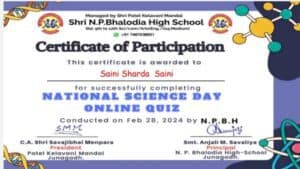 Organizer : Managed by Shri Patel Kelavani Mandal Shri N.P.Bhalodia High School
Organizer : Managed by Shri Patel Kelavani Mandal Shri N.P.Bhalodia High School
National Science Day in India is celebrated annually on February 28 to commemorate the discovery of “Raman Effect” by Indian physicist Sir Chandrasekhara Venkata Raman (C.V. Raman). The occasion also serves as a platform to appreciate and raise public awareness about the contributions of our scientific community toward the development of our nation.
About the Quiz
- Attempt the Quiz only once
- Score will be released only after
closing of the quiz. - If total marks scored is above 50% of the maximum marks , then E-certificate will be emailed in immediately or within 2minutes.
- 100% Correct Answers on YouTube vedio Link
Apply Link
C.A. Shri Savajibhai Menpara
President: Patel Kelavani Mandal Junagadh.
Smt. Anjali M. Savaliya Principal N. P. Bhalodia High-School Junagadh.
100% Correct Answers Here
Q1. Who discovered the Raman Effect, which is celebrated on National Science Day?
*
1 point
A) Albert Einstein
B) Isaac Newton
C) Sir C. V. Raman
D) Marie Curie
Q2. In which year was the Raman Effect discovered?
*
1 point
A) 1928
B) 1930
C) 1945
D) 1952
Q3. National Science Day is celebrated in India on:
*
1 point
A) February 28
B) January 26
C) April 22
D) March 15
Q4. What was the scientific significance of Sir C. V. Raman’s discovery?
*
1 point
A) Discovery of X-rays
B) Discovery of DNA structure
C) Discovery of electron
D) Discovery of change in wavelength of light
Q5. What is the theme for National Science Day 2024?
*
1 point
A) Science for Innovation
B) Indigenous Technologies for Viksit Bharat
C) Science for Global Harmony
D) Science for Health and Wellness
Q6. What is Earth’s only natural satellite
*
1 point
A) Sun
B) Mars
C) Venus
D) Moon
Q7. Which animal lays eggs?
*
1 point
A) Dog
B) Cat
C) Duck
D) Sheep
Q8. Sir C. V. Raman won the Nobel Prize in Physics in which year?
*
1 point
A) 1930
B) 1945
C) 1928
D) 1952
Q9. The Raman Effect is concerned with the:
*
1 point
A) Reflection of light
B) Refraction of light
C) Scattering of light
D) Absorption of light
Q10. Which biologist proposed the theory of evolution through natural selection?
*
1 point
A) Charles Darwin
B) Stephen Hawking
C) Francesco Redi
D) Alexander Fleming
11) In which year was the first National Science Day celebrated in India?
*
1 point
A) 1971
B) 1980
C) 1985
D) 1995
12) Who is known as the father of Indian science?
*
1 point
A) C.V. Raman
B) Jagdish Chandra Bose
C) Homi J. Bhabha
D) Vikram Sarabhai
13) The Indian Space Research Organization (ISRO) was established in which year?
*
1 point
A) 1950
B) 1960
C) 1970
D) 1980
14) Who is known as the father of the Indian space program?
*
1 point
A) C.V. Raman
B) Homi J. Bhabha
C) Vikram Sarabhai
D) Jagdish Chandra Bose
15) Who is considered as the first female engineer from India?
*
1 point
A) Anandi Gopal Joshi
B) Kalpana Chawla
C) Savitribai Phule
D) Indira Nooyi
16) Which is the largest animal on earth?
*
1 point
A) Shark
B) Elephant
C) Blue whale
D) Giraffe
17) The Indian Institute of Science (IISc) was established in which year?
*
1 point
A) 1909
B) 1919
C) 1929
D) 1939
18) Who among the following was the first Indian to receive a Nobel Prize in Chemistry?
*
1 point
a) C.V. Raman
b) Homi J. Bhabha
c) Venkatraman Ramakrishnan
d) Har Gobind Khorana
19) The acronym “Vigyan Jyoti” is associated with which initiative in India?
1 point
A) Promoting women’s education in science and technology
B) Encouraging rural youth to pursue careers in science
C) Popularizing science and technology among school children
D) Developing scientific infrastructure in remote areas
20) Which famous Indian mathematician is known for his contribution to number theory, algebra, and infinite series?
1 point
A) Ramanujan
B) Aryabhata
C) Brahmagupta
D) Bhaskara II
